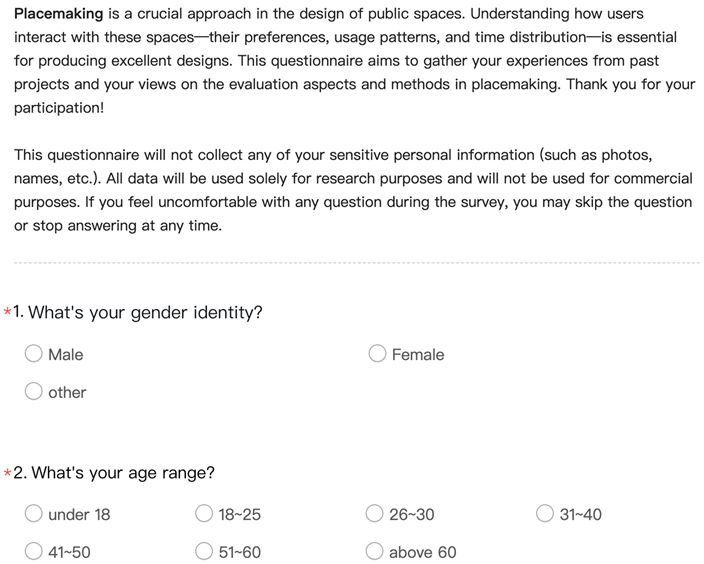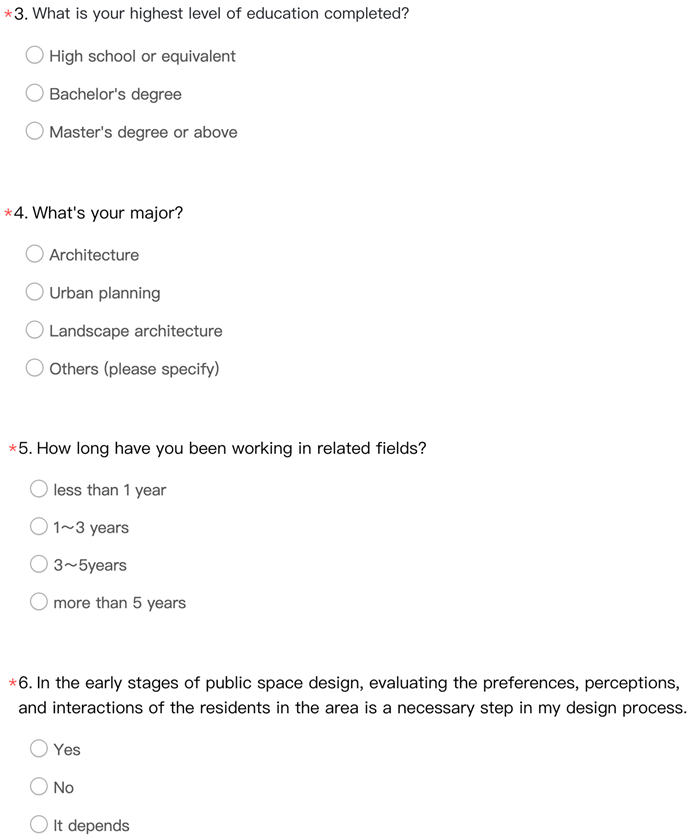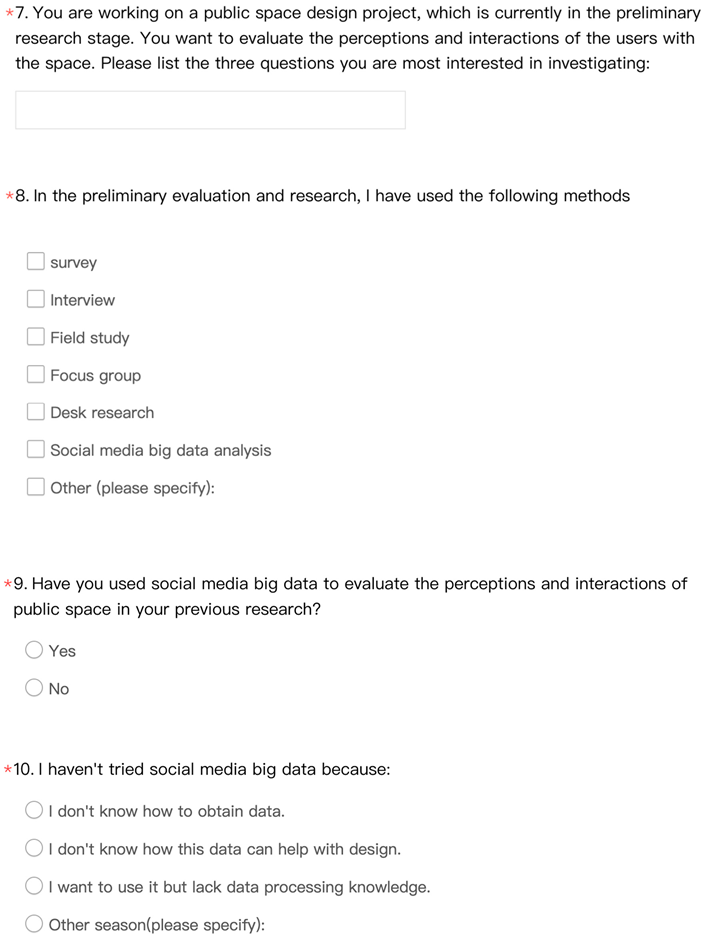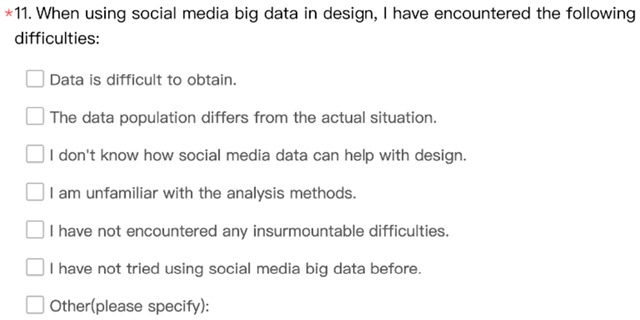Understanding How People Perceive and Interact with Public Space through Social Media Big Data: A Case Study of Xiamen, China
Abstract
1. Introduction
2. Literature Review
2.1. Evaluating Perception and Interaction of Public Spaces
2.2. SMBD in Public Placemaking
3. Materials and Methods
3.1. Overall Methods
3.2. Preliminary Survey and Interview
3.3. Study Area
3.4. Dataset
3.5. Social Sentiment
3.6. Leisure Activities
3.7. Vibrancy Heatmap
3.8. Visitor’s Activities
3.9. Preferred Visual Elements
4. Results
4.1. Five Key Aspects of Evaluating Perception and Interaction of Public Spaces
Discussion of the Survey and Interview
4.2. Perception and Interaction of Public Spaces in Xiamen
4.2.1. Social Sentiment
4.2.2. Leisure Activities
4.2.3. Vibrancy Heatmap
4.2.4. Visitor’s Activities
4.2.5. Preferred Visual Elements
4.2.6. Overall Result Analysis
5. Discussion
6. Conclusions
6.1. Limitation
6.2. Future Research Direction
Author Contributions
Funding
Data Availability Statement
Acknowledgments
Conflicts of Interest
Appendix A
- Online Survey
References
- Wyckoff, Y.M.A. Definition of Placemaking: Four Different Types. Planning & Zoning News, 2014. Available online: https://yieldpro.com/pdf/issues/2024/4typesplacemaking_pzn_wyckoff_january2014.pdf (accessed on 1 August 2024).
- Cracknell, D. What Is Placemaking? Placemaking Education. Available online: https://placemaking.education/p/whatisplacemaking (accessed on 1 August 2024).
- Burgess, R.G. In the Field: An Introduction to Field Research; Unwin Hyman: London, UK, 2002. [Google Scholar]
- Marry, S.; Defrance, J. Analysis of the perception and representation of sonic public spaces through on site survey, acoustic indicators and in-depth interviews. Appl. Acoust. 2013, 74, 282–292. [Google Scholar] [CrossRef]
- Li, P.; Froese, T.M.; Brager, G. Post-occupancy evaluation: State-of-the-art analysis and state-of-the-practice review. Build. Environ. 2018, 133, 187–202. [Google Scholar] [CrossRef]
- Ren, K.; Sun, X.; Cenci, J.; Zhang, J. Assessment of public open space research hotspots, vitalities, and outlook using CiteSpace. J. Asian Archit. Build. Eng. 2023, 22, 3799–3817. [Google Scholar] [CrossRef]
- Rodiek, S.D.; Fried, J.T. Access to the outdoors: Using photographic comparison to assess preferences of assisted living residents. Landsc. Urban. Plan. 2005, 73, 184–199. [Google Scholar] [CrossRef]
- Wong, B. Top Social Media Statistics and Trends of 2023. Forbes Advisor. 2023. Available online: https://www.forbes.com/advisor/business/social-media-statistics/ (accessed on 1 August 2024).
- Huang, Q.; Wong, D.W.S. Modeling and Visualizing Regular Human Mobility Patterns with Uncertainty: An Example Using Twitter Data. Ann. Assoc. Am. Geogr. 2015, 105, 1179–1197. [Google Scholar] [CrossRef]
- Chen, T.; Hui, E.C.M.; Wu, J.; Lang, W.; Li, X. Identifying urban spatial structure and urban vibrancy in highly dense cities using georeferenced social media data. Habitat Int. 2019, 89, 102005. [Google Scholar] [CrossRef]
- Zhang, Y.; Li, Q.; Tu, W.; Mai, K.; Yao, Y.; Chen, Y. Functional urban land use recognition integrating multi-source geospatial data and cross-correlations. Comput. Environ. Urban Syst. 2019, 78, 101374. [Google Scholar] [CrossRef]
- Ardi, Z.; Putri, S.A. The analysis of the social media impact on the millennial generation behavior and social interactions. Southeast Asian J. Technol. Sci. 2020, 1, 70–77. [Google Scholar]
- Sun, R.; Rieble, C.; Liu, Y.; Sauter, D. Connected Despite Lockdown: The Role of Social Interactions and Social Media Use in Wellbeing. Collabra Psychol. 2022, 8, 37061. [Google Scholar] [CrossRef]
- Honorato, J.I.; Cypriano, L.O.; Goveia, F.; Carreira, L. Colors of the street: Color as an image visualization parameter of Twitter pictures from Brazil’s 2013 protests. CEUR Workshop Proc. 2014, 1210. [Google Scholar]
- Yue, L.; Chen, W.; Li, X.; Zuo, W.; Yin, M. A survey of sentiment analysis in social media. Knowl. Inf. Syst. 2019, 60, 617–663. [Google Scholar] [CrossRef]
- Ye, C.; Zhang, F.; Mu, L.; Gao, Y.; Liu, Y. Urban function recognition by integrating social media and street-level imagery. Environ. Plan. B Urban Anal. City Sci. 2021, 48, 1430–1444. [Google Scholar] [CrossRef]
- Wu, C.; Ye, X.; Ren, F.; Du, Q. Check-in behaviour and spatio-temporal vibrancy: An exploratory analysis in Shenzhen, China. Cities 2018, 77, 104–116. [Google Scholar] [CrossRef]
- Kim, H.J.; Chae, B.K.; Park, S.B. Exploring public space through social media: An exploratory case study on the High Line New York City. Urban Des. Int. 2018, 23, 69–85. [Google Scholar] [CrossRef]
- Viner, R.M.; Gireesh, A.; Stiglic, N.; Hudson, L.D.; Goddings, A.L.; Ward, J.L.; Nicholls, D.E. The role of cyberbullying, sleep and physical activity in mediating the impact of social media use on mental health and wellbeing: Findings from a national cohort of English young people. Lancet Child Adolesc. Health 2019, 3, 685–696. [Google Scholar] [CrossRef]
- Carmona, M. Re-theorising contemporary public space: A new narrative and a new normative. J. Urban. 2015, 8, 373–405. [Google Scholar] [CrossRef]
- Praliya, S.; Garg, P. Public space quality evaluation: Prerequisite for public space management. J. Public Space 2019, 4, 93–126. [Google Scholar] [CrossRef]
- Mehta, V. Evaluating Public Space. J. Urban Des. 2013, 19, 53–88. [Google Scholar] [CrossRef]
- Carmona, M. Public Places Urban Spaces: The Dimensions of Urban Design. In Public Places Urban Spaces: The Dimensions of Urban Design; Routledge: London, UK, 2021. [Google Scholar] [CrossRef]
- Madanipour, A.; Knierbein, S.; Degros, A. Public Space and the Challenges of Urban Transformation in Europe. In Public Space and the Challenges of Urban Transformation in Europe; Routledge: London, UK, 2013. [Google Scholar] [CrossRef]
- Iveson, K. Cities within the City: Do-It-Yourself Urbanism and the Right to the City. Int. J. Urban Reg. Res. 2013, 37, 941–956. [Google Scholar] [CrossRef]
- Low, S.; Iveson, K. Propositions for more just urban public spaces. City 2016, 20, 10–31. [Google Scholar] [CrossRef]
- Yavuz, N.; Welch, E.W. Addressing fear of crime in public space: Gender differences in reaction to safety measures in train transit. Urban Stud. 2010, 47, 2491–2515. [Google Scholar] [CrossRef] [PubMed]
- Gehl, J. Life between Buildings: Using Public Space; Danish Architectural Press: Copenhagen, Denmark, 1971. [Google Scholar]
- Tuncer, S.; Laurier, E.; Brown, B.; Licoppe, C. Notes on the practices and appearances of e-scooter users in public space. J. Transp. Geogr. 2020, 85, 102702. [Google Scholar] [CrossRef]
- Peters, K. Being together in urban parks: Connecting public space, leisure, and diversity. Leis. Sci. 2010, 32, 418–433. [Google Scholar] [CrossRef]
- Andargie, M.S.; Azar, E. An applied framework to evaluate the impact of indoor office environmental factors on occupants’ comfort and working conditions. Sustain. Cities Soc. 2019, 46, 101447. [Google Scholar] [CrossRef]
- Silva, T.H.; De Melo, P.O.S.V.; Almeida, J.M.; Salles, J.; Loureiro, A.A.F. Revealing the city that we cannot see. ACM Trans. Internet Technol. 2014, 14, 1–23. [Google Scholar] [CrossRef]
- Batty, M. The New Science of Cities; MIT Press: Cambridge, MA, USA, 2013. [Google Scholar] [CrossRef]
- Kemp, S. Digital 2024: Global Overview Report. 2024. Available online: https://datareportal.com/reports/digital-2024-global-overview-report (accessed on 1 August 2024).
- Carlos, M.A.; Nogueira, M.; Machado, R.J. Analysis of dengue outbreaks using big data analytics and social networks. In Proceedings of the 2017 4th International Conference on Systems and Informatics, ICSAI 2017, Hangzhou, China, 11–13 November 2017; Institute of Electrical and Electronics Engineers Inc.: Shenzhen, China, 2017; Volume 2018, pp. 1592–1597. [Google Scholar]
- Ghani, N.A.; Hamid, S.; Targio Hashem, I.A.; Ahmed, E. Social media big data analytics: A survey. Comput. Hum. Behav. 2019, 101, 417–428. [Google Scholar] [CrossRef]
- Rahman, M.S.; Reza, H. A Systematic Review Towards Big Data Analytics in Social Media. Big Data Min. Anal. 2022, 5, 228–244. [Google Scholar] [CrossRef]
- Mishra, G.; Rastogi, S. A Survey on Opinion Mining of Real Time Data Using Big Data Analytics. Int. J. Comput. Appl. Technol. 2016, 7, 247–252. [Google Scholar]
- Uma Maheswari, S.; Dhenakaran, S.S. Sentiment analysis on social media big data with multiple tweet words. Int. J. Innov. Technol. Explor. Eng. 2019, 8, 3429–3434. [Google Scholar] [CrossRef]
- Evans-Cowley, J.S.; Griffin, G. Microparticipation with Social Media for Community Engagement in Transportation Planning. Transp. Res. Rec. 2012, 2307, 90–98. [Google Scholar] [CrossRef]
- Heikinheimo, V.; Tenkanen, H.; Bergroth, C.; Järv, O.; Hiippala, T.; Toivonen, T. Understanding the use of urban green spaces from user-generated geographic information. Landsc. Urban Plan. 2020, 201, 103845. [Google Scholar] [CrossRef]
- Chen, D.; Long, X.; Li, Z.; Liao, C.; Xie, C.; Che, S. Exploring the determinants of urban green space utilization based on microblog check-in data in Shanghai, China. Forests 2021, 12, 1783. [Google Scholar] [CrossRef]
- Duan, S.; Shen, Z.; Luo, X. Exploring the Relationship between Urban Youth Sentiment and the Built Environment Using Machine Learning and Weibo Comments. Int. J. Environ. Res. Public Health 2022, 19, 4794. [Google Scholar] [CrossRef] [PubMed]
- Resch, B.; Summa, A.; Sagl, G.; Zeile, P.; Exner, J.P. Urban Emotions—Geo-Semantic Emotion Extraction from Technical Sensors, Human Sensors and Crowdsourced Data. In Progress in Location-Based Services 2014; Lecture Notes in Geoinformation and Cartography; Springer: New York, NY, USA, 2015. [Google Scholar] [CrossRef]
- De Nadai, M.; Staiano, J.; Larcher, R.; Sebe, N.; Quercia, D.; Lepri, B. The death and life of great Italian cities: A mobile phone data perspective. In Proceedings of the 25th International World Wide Web Conference, WWW 2016, Montreal, QC, Canada, 11–15 April 2016. [Google Scholar] [CrossRef]
- Frias-Martinez, V.; Frias-Martinez, E. Spectral clustering for sensing urban land use using Twitter activity. Eng. Appl. Artif. Intell. 2014, 35, 237–245. [Google Scholar] [CrossRef]
- Plunz, R.A.; Zhou, Y.; Vintimilla, M.I.C.; Mckeown, K.; Yu, T.; Uguccioni, L.; Sutto, M.P. Twitter sentiment in New York City parks as measure of well-being. Landsc. Urban Plan. 2019, 189, 235–246. [Google Scholar] [CrossRef]
- Du, R.; Varshney, A. Social street view: Blending immersive street views with geo-Tagged social media. In Proceedings of the 21st International Conference on Web3D Technology, Web3D 2016, Anaheim, CA, USA, 22–24 July 2016. [Google Scholar] [CrossRef]
- Psyllidis, A.; Yang, J.I.E.; Bozzon, A. Regionalization of Social Interactions and Points-of-Interest Location Prediction with Geosocial Data. IEEE Access 2018, 6, 34334–34353. [Google Scholar] [CrossRef]
- Braun, V.; Clarke, V.; Braun, V.; Clarke, V. Applied Qualitative Research in Psychology; Red Globe Press: New York, NY, USA, 2017. [Google Scholar]
- Tomitsch, M.; Wrigley, C.; Borthwick, M.; Ahmadpour, N.; Frawley, J.; Kocaballi, A.B.; Nunez-Pacheco, C.; Straker, K. Design. Think. Make. Break. Repeat. A Handbook of Methods; BIS Publishers: Amsterdam, The Netherlands, 2018. [Google Scholar]
- 2023 Top Chinese Social Media Platforms, Sites and Apps You Need to Know. Azoya, 2023. Available online: https://www.azoyagroup.com/page/view/top-chinese-social-media-platform-you-need-to-know/#_ftn1 (accessed on 1 August 2024).
- Ernie. Available online: https://github.com/PaddlePaddle/ERNIE (accessed on 1 August 2024).
- SnowNLP. Available online: https://github.com/isnowfy/snownlp (accessed on 1 August 2024).
- Guo, Y.; Barnes, S.J.; Jia, Q. Mining meaning from online ratings and reviews: Tourist satisfaction analysis using latent Dirichlet allocation. Tour. Manag. 2017, 59, 467–483. [Google Scholar] [CrossRef]
- Synonyms. Available online: https://www.chinese-tools.com/tools/synonyms.html (accessed on 1 August 2024).
- GooSeeker. Available online: https://www.gooseeker.com/ (accessed on 1 August 2024).
- Bailey, T.C.; Gatrell, A.C. Interactive Spatial Data Analysis; Longman Scientific & Technical: Essex, UK, 1995. [Google Scholar]
- Lynch, K. The Image of the City; MIT Press: Cambridge, MA, USA, 1960. [Google Scholar]
- Veal, A.J. The Serious Leisure Perspective and the Experience of Leisure. Leis. Sci. 2017, 39, 205–223. [Google Scholar] [CrossRef]
- Wang, R.; Yang, B.; Yao, Y.; Bloom, M.S.; Feng, Z.; Yuan, Y.; Zhang, J.; Liu, P.; Wu, W.; Lu, Y.; et al. Residential greenness, air pollution and psychological well-being among urban residents in Guangzhou, China. Sci. Total Environ. 2020, 711, 134843. [Google Scholar] [CrossRef]
- Cohen, D.A.; Han, B.; Derose, K.P.; Williamson, S.; Marsh, T.; Raaen, L.; McKenzie, T.L. The Paradox of Parks in Low-Income Areas: Park Use and Perceived Threats. Environ. Behav. 2016, 48, 230–245. [Google Scholar] [CrossRef]
- John, M. Making a City: Urbanity, Vitality and Urban Design. J. Urban Des. 1998, 3, 93–116. [Google Scholar]
- Jacobs, J. The Death and Life of Great American Cities; Vintage: New York, NY, USA, 1961. [Google Scholar]
- Shokry, G.; Connolly, J.J.; Anguelovski, I. Understanding climate gentrification and shifting landscapes of protection and vulnerability in green resilient Philadelphia. Urban Clim. 2020, 31, 100539. [Google Scholar] [CrossRef]
- Yin, L.; Cheng, Q.; Wang, Z.; Shao, Z. ‘Big data’ for pedestrian volume: Exploring the use of Google Street View images for pedestrian counts. Appl. Geogr. 2015, 63, 337–345. [Google Scholar] [CrossRef]
- Barreca, A.; Curto, R.; Rolando, D. Urban vibrancy: An emerging factor that spatially influences the real estate market. Sustainability 2020, 12, 346. [Google Scholar] [CrossRef]
- Wang, K.Y. Sustainable Tourism Development Based upon Visitors’ Brand Trust: A Case of “100 Religious Attractions”. Sustainability 2022, 14, 1977. [Google Scholar] [CrossRef]
- Edwards, D.; Griffin, T.; Hayllar, B. Urban Tourism Research. Developing an Agenda. Ann. Tour. Res. 2008, 35, 1032–1052. [Google Scholar] [CrossRef]
- Timur, S.; Getz, D. Sustainable tourism development: How do destination stakeholders perceive sustainable urban tourism? Sustain. Dev. 2009, 17, 220–232. [Google Scholar] [CrossRef]
- Geng, Z.; Le, W.; Guo, B.; Yin, H. Analysis of factors affecting visual comfort in hotel lobby. PLoS ONE 2023, 18, e0280398. [Google Scholar] [CrossRef]
- Lin, W.; Chen, Q.; Jiang, M.; Zhang, X.; Liu, Z.; Tao, J.; Wu, L.; Xu, S.; Kang, Y.; Zeng, Q. The effect of green space behaviour and per capita area in small urban green spaces on psychophysiological responses. Landsc. Urban Plan. 2019, 192, 103637. [Google Scholar]
- Brady, E.; Prior, J. Environmental aesthetics: A synthetic review. People Nat. 2020, 2, 254–266. [Google Scholar] [CrossRef]
- Qi, J.; Mazumdar, S.; Vasconcelos, A.C. Understanding the Relationship between Urban Public Space and Social Cohesion: A Systematic Review. Int. J. Community Well-Being 2024, 7, 155–212. [Google Scholar] [CrossRef]
- Townsend, A.M. Smart Cities: Big Data, Civic Hackers, and the Quest for a New Utopia; W. W. Norton & Company: New York, NY, USA, 2014. [Google Scholar] [CrossRef]
- Fernandez, J.; Song, Y.; Padua, M.; Liu, P. A Framework for Urban Parks: Using Social Media Data to Assess Bryant Park, New York. Landsc. J. 2022, 41, 15–29. [Google Scholar] [CrossRef]
- Martini, B. The Data Revolution. Big Data, Open Data, Data Infrastructures and Their Consequences. Reg. Stud. 2016, 50, 553–554. [Google Scholar] [CrossRef]
- Shelton, T.; Zook, M.; Wiig, A. The ‘actually existing smart city’. Camb. J. Reg. Econ. Soc. 2015, 8, 13–25. [Google Scholar] [CrossRef]
- Sina Finance. Weibo User Development Report. Available online: https://finance.sina.cn/tech/2021-03-12/detail-ikkntiak9143019.d.html?fromtech=1 (accessed on 1 August 2024).

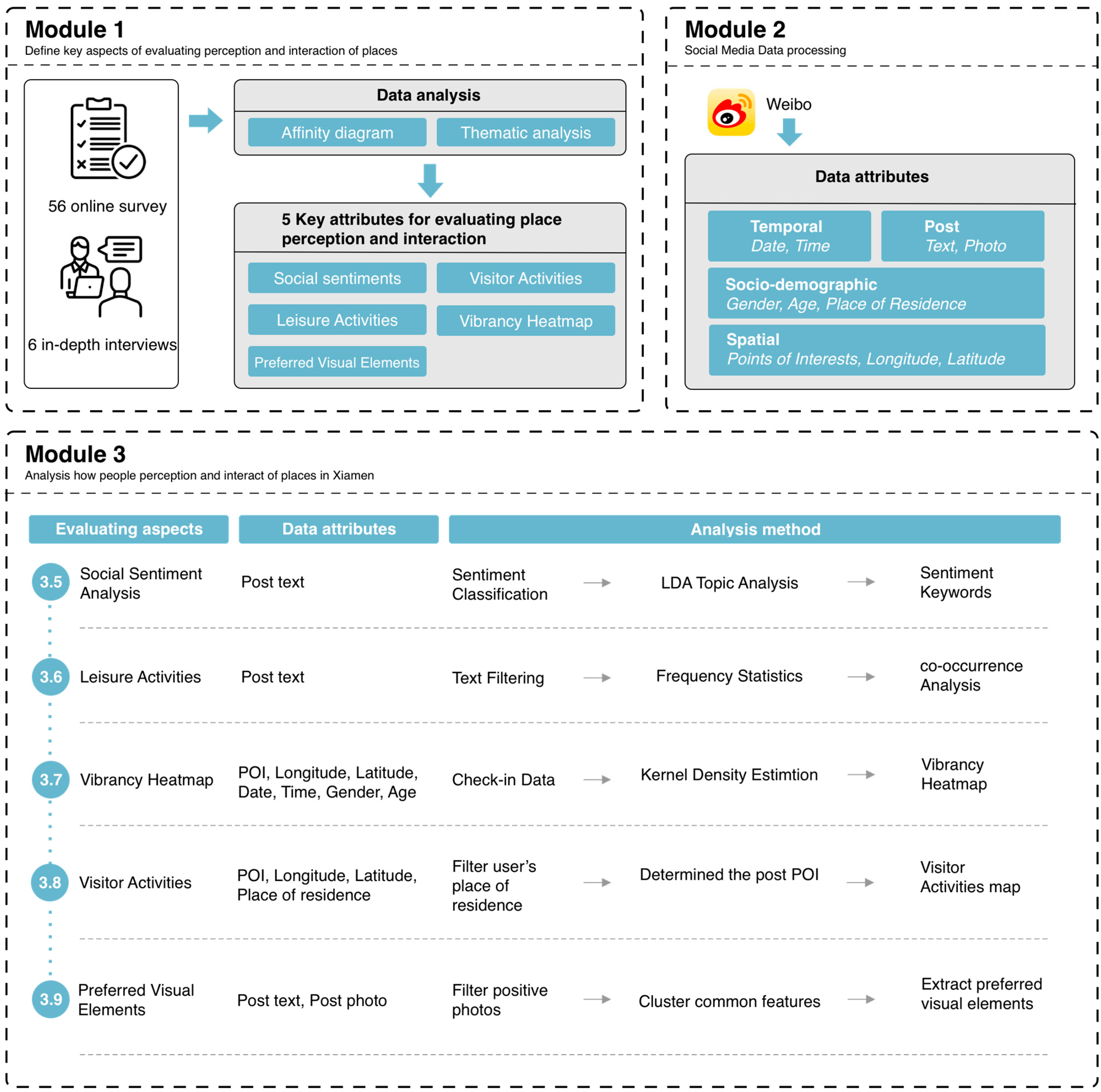

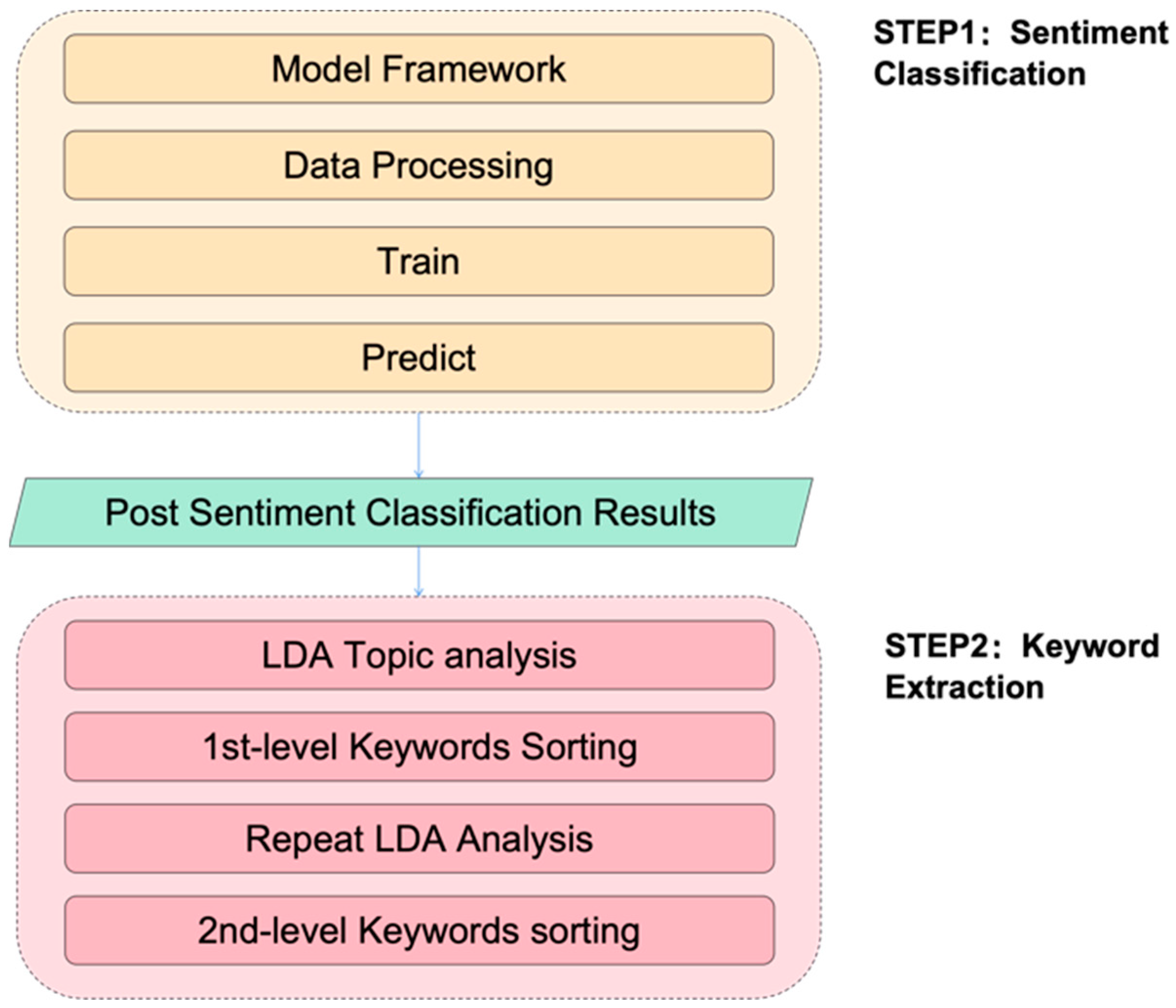

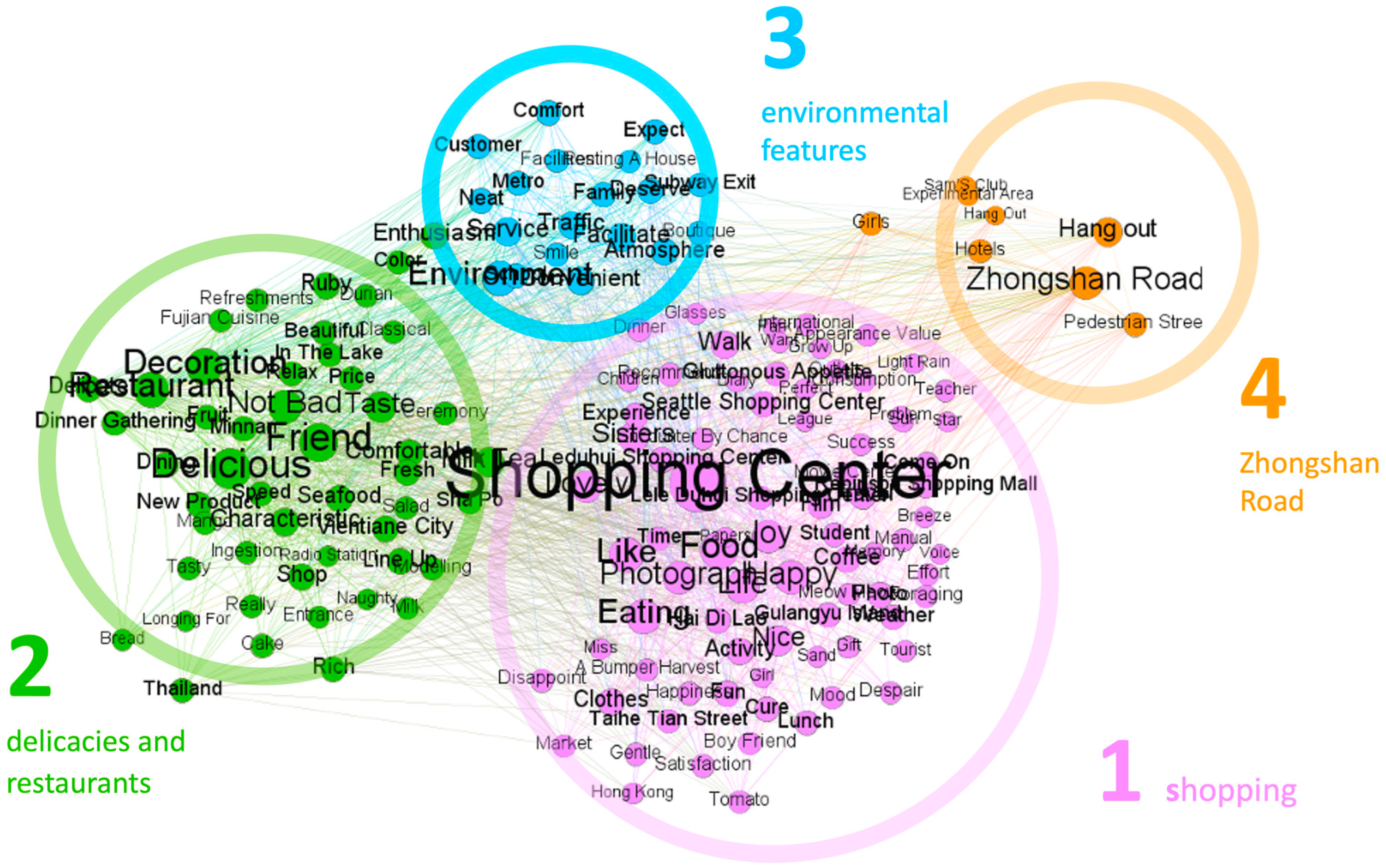


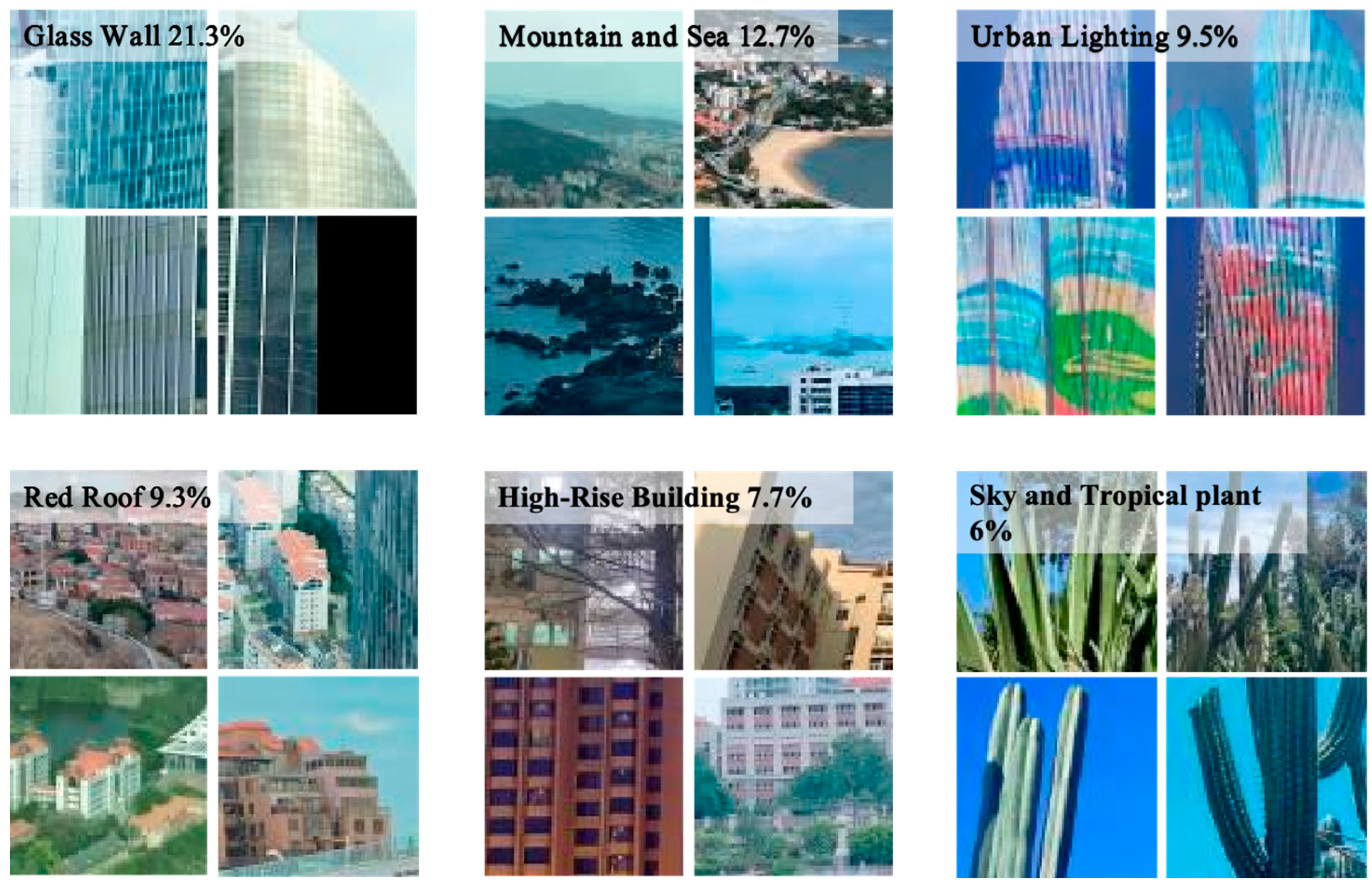
| Participant Number | Age | Education | Professional Role | Professional Experience |
|---|---|---|---|---|
| No. 1 | 37 | Landscape Architecture | Landscape Architect | 7 years |
| No. 2 | 27 | Architecture | Architect | 3 years |
| No. 3 | 30 | Urban Planning | Urban Planner | 4 years |
| No. 4 | 31 | Urban Planning | Urban Planner | 6 years |
| No. 5 | 27 | Urban Planning | Urban Planner | 4 years |
| No. 6 | 36 | Urban Planning | Urban Planner | 10 years |
| Type of Variable | Attribute | Proxy |
|---|---|---|
| Temporal | Date | The date of posting (Year/Month/Day). |
| Time | The time of posting. | |
| Socio-demographic | Gender | The gender of the user. |
| Age | The age of the user. | |
| Place of Residence | The geographical location where the user registered. | |
| Post | Text | The textual content of the posts. |
| Photo | The photo of the posts. | |
| Spatial | Points of Interests | The location-based Points of Interest associated with the posts. |
| Longitude | The longitude coordinates are associated with the posts. | |
| Latitude | The latitude coordinates are associated with the posts. |
| Sentiment | Text |
|---|---|
| Positive | “Lifting my head, I see the dappled shadow of the sun weaving through the tree canopy”. |
| “Craving for satay noodles!” | |
| Negative | “It’s TOOOOOOO hot!!” |
| “I hate the traffic at the Xiang’an South Road”. |
| Pivotal Topics | Subtopics | Text Example |
|---|---|---|
| Gourmet (Positive) | Satay noodles | “It’s brimming with the flavours of childhood”. |
| Seafood | “The right way to enjoy summer is at Xiamen’s seafood market”. | |
| Travel (Positive) | Scenery | “Every street and alley in Xiamen is a picture”. |
| Record | “Capturing the beauty of life is a beautiful thing in itself”. | |
| Check-in | “Checking in the new recommended delicacies from social media influencers”! | |
| Business (Positive) | Plaza | “Xiamen is evolving into a fashionable and creative urban hub, leaving a different impression with every visit”. |
| City | “Xiamen is the city filled with the spirit of cultural creativity”. | |
| Communication | “I will visit Xiamen more often for business collaborations”! | |
| Weather (Negative) | Hot | “The temperature on the beach could probably roast potatoes”! |
| Summer | “Summer can be a frustrating season with its heat and humidity”. | |
| Mosquito | “So many mosquitoes, and the weather is scorching hot”! | |
| Transportation (Negative) | pedestrian walkways | “Why isn’t there a sidewalk for such a beautiful view”? |
| City Management (Negative) | Disturbance | “The road next to my home was under construction forever”. |
Disclaimer/Publisher’s Note: The statements, opinions and data contained in all publications are solely those of the individual author(s) and contributor(s) and not of MDPI and/or the editor(s). MDPI and/or the editor(s) disclaim responsibility for any injury to people or property resulting from any ideas, methods, instructions or products referred to in the content. |
© 2024 by the authors. Licensee MDPI, Basel, Switzerland. This article is an open access article distributed under the terms and conditions of the Creative Commons Attribution (CC BY) license (https://creativecommons.org/licenses/by/4.0/).
Share and Cite
Li, S.; Wang, C.; Rong, L.; Zhou, S.; Wu, Z. Understanding How People Perceive and Interact with Public Space through Social Media Big Data: A Case Study of Xiamen, China. Land 2024, 13, 1500. https://doi.org/10.3390/land13091500
Li S, Wang C, Rong L, Zhou S, Wu Z. Understanding How People Perceive and Interact with Public Space through Social Media Big Data: A Case Study of Xiamen, China. Land. 2024; 13(9):1500. https://doi.org/10.3390/land13091500
Chicago/Turabian StyleLi, Shuran, Chengwei Wang, Liying Rong, Shiqi Zhou, and Zhiqiang Wu. 2024. "Understanding How People Perceive and Interact with Public Space through Social Media Big Data: A Case Study of Xiamen, China" Land 13, no. 9: 1500. https://doi.org/10.3390/land13091500
APA StyleLi, S., Wang, C., Rong, L., Zhou, S., & Wu, Z. (2024). Understanding How People Perceive and Interact with Public Space through Social Media Big Data: A Case Study of Xiamen, China. Land, 13(9), 1500. https://doi.org/10.3390/land13091500





